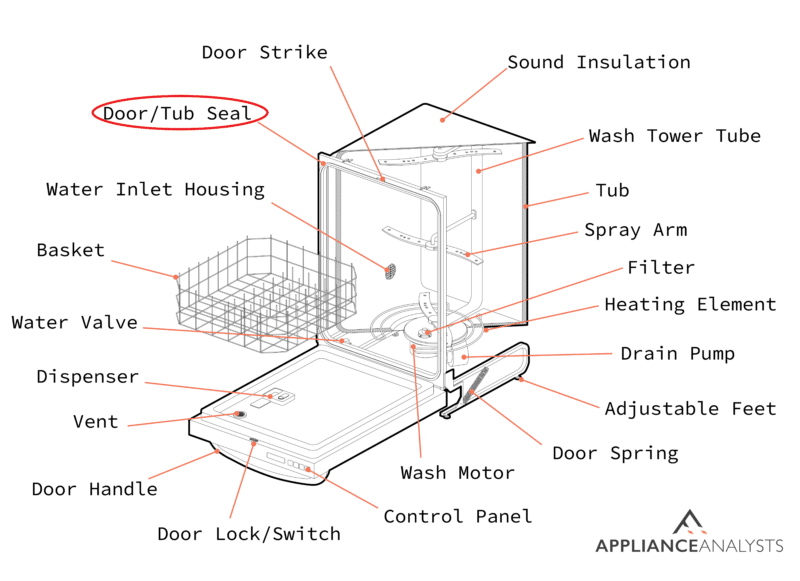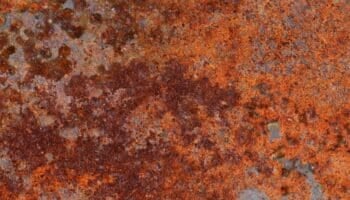We've independently reviewed this article to make sure it's as accurate as we can make it.
To find out more about our article creation and review process, check out our editorial guidelines.
The dishwasher is loaded and ready, but the soap dispenser won’t close.
It just won’t stay secure no matter how hard you push down or twist. So what can you do?
The good news is there are some easy things to try before looking for replacement parts or calling a technician or your warranty representative (home or manufacturer). First, though, you need to identify the following:
- How’s your dishwasher controlled?
- What type of detergent cup does your dishwasher have?
- Is your dishwasher OFF?
Don’t worry, though – these are all simple questions.
I’ll walk you through each of them.
From there, we’ll get into the different fixes you can try to solve the issue of the dishwasher soap dispenser not closing.
By the end of this article, I’m sure we’ll have solved your issue and got your dishwasher working again.
If that sounds good, then let’s dive in!
What Type of Controller Does Your Dishwasher Have?
Figuring out the type of controller your dishwasher has should be quick. If you have an electronic control dishwasher, you’ll have a series of nice buttons to push on the top or front of your dishwasher’s door. If you have a mechanical control dishwasher, you’ll have a rotating knob on the front of the dishwasher door that cycles clockwise from START through the chosen cycle and eventually to OFF.
Troubleshoot an Electronic Control Dishwasher Soap Dispenser
If you have a dishwasher with electronic controls, start troubleshooting by ensuring the dishwasher has yet to start a cycle. If it has, it is not technically OFF and may not allow the soap cup to function correctly. It may even beep to let you know it’s not OFF, and you should resume the cycle. Don’t. Instead, let’s assume it’s not OFF.
Ensure that the dishwasher has yet to start the cycle.
For an electronic control dishwasher, to reset or cancel the cycle, you usually either have to push the START button for 3 seconds until it resets or push it twice for it to reset. Models and procedures vary, so consult the owner’s manual for your manufacturer’s recommendations.
Once you’re sure it is OFF, try closing the soap dispenser. If it closes, you can be sure that an ongoing cycle is the issue. However, if it still doesn’t, you’ll have to try other things in this post.
Troubleshoot a Mechanical Control Dishwasher Soap Dispenser
As with the electronic control dishwasher, you should ensure the control knob is entirely rotated to OFF if you have a mechanical control dishwasher. If the knob is past OFF, manually turn it clockwise to OFF.
Like an electronic control dishwasher, the soap cup may not function properly if a mechanical control dishwasher isn’t in the OFF position.
Make sure that the control knob is completely OFF.
Try closing the soap dispenser once you’ve moved the control knob to the correct position. If it closes, the control knob’s position is the issue, as stated in the case of an electronic control dishwasher. But it doesn’t close; sit tight.
Time to move on to the next round of troubleshooting.
What Type of Soap Dispenser Does Your Dishwasher Have?
Here, you’ll have three to identify from.
- Sliding Cover
- Flip-Up Cover
- Round Cover
Sliding Cover
Before putting in any detergent, ensure the sliding cover in your dishwasher has a free range of motion. It should slide down over the cup, where it should click shut. During regular operation, the door will spring open by sliding up and releasing the detergent.
Try to push the cover down and click into place. No click? Not good.
Flip-Up Cover
Before putting in any detergent, ensure the cover in your dishwasher has a free range of motion—these types of covers function like a trap door, only in reverse. In normal operation, the cover remains closed until activated, where it springs open, releasing the detergent.
Try rotating the lid down and clicking it into place. No click? Time to try something else.
Round Cover
For the round cover in your dishwasher, twist counterclockwise to open, ensuring a free range of motion. Turn clockwise to lock into place. If it doesn’t click, it’s not functioning correctly.
Common Problems to Check Before Calling a Technician
There is a laundry list of dishwasher issues to check before you call a technician (or the warranty people). These will allow you to exhaust all the possibilities without paying anything out of pocket. And if you still need to solve the problem, you at least know it’s time to call for help, and it’s probably not a simple fix.
Soap Buildup
Soap buildup is a common issue in a dishwasher when the detergent isn’t used fully during a cycle or if the cover has only been partially opened due to a defect or obstacle (like a large baking sheet blocking it from opening or fully releasing).
In these cases, soap builds up on the dishwasher’s latch, keeping the door from snapping in place or staying closed when it’s supposed to. Soap buildup can also affect how efficiently the door opens. Lastly, soap can also build up on the door’s gasket seal, preventing proper closure.
If you notice soap buildup around the dishwasher’s door and its associated parts, properly clean it and see how the door functions once done. Use a simple toothbrush with hot water and a vinegar cleaning solution to help scrub it away.
Waste Buildup
Like soap, other items can build up within your dishwasher and can affect the functionality of your soap dispenser door. With dishwashers, it could be food, grease, etc. All the stuff the appliance is supposed to take care of.
Clean your dishwasher to avoid any buildup.
Over time, dishwashers handle a lot of waste. The older they get, the more maintenance and upkeep they require. However, efficiency does tend to deteriorate the longer and harder they work.
As a result, it’s not uncommon to find calcium or soap buildup on everything from the dispenser door to the nozzles and jets. And along with calcium/soap buildup comes food waste. Look for anything that might “gunk up the works,” so to speak, and clean it up.
Inspect the Gasket Seal
When inspecting the dishwasher’s gasket seal for soap buildup, also check the material condition of the seal. Look to see if it’s worn, cut, or crumbling. If it’s an older dishwasher, it may be as simple as replacing the gasket for proper functioning.
If the gasket seal looks good but is dry, lubricate it with a thin layer of petroleum jelly. It may be as simple as adding some lubrication to get the door closed again.

Door Latch
Checking the door latch is another thing that can quickly address the problem of your Beko dishwasher’s soap dispenser door not closing. Even if the latch looks okay and is not broken, it may be chipped or cracked enough that it can’t hold the door securely, failing to keep it closed.
Rinse Dispenser Cover
Not all dishwashers come with a rinse dispenser cup, but if yours does, check the cover of it. It, too, may have some buildup or a problem with a gasket that’s keeping it from closing completely. In such a case, it could affect the functionality of the soap dispenser door and the cycle functions of the dishwasher entirely.
Detergent
If you’ve switched detergents recently and are now having a problem with the dishwasher soap dispenser door, make sure the pods or tablets you may be using aren’t too big for the soap cup. Also, ensure you’re not overfilling the cup using liquid or powdered detergent.
Preventing Dishwasher Soap Dispenser Issues
While useful, all the tips provided above have been reactive, not proactive. In other words, they’re suggested from a troubleshooting perspective rather than one of preparedness. Although you can’t get ahead of some things, proper maintenance can keep others at bay.
Here are some good habits you’ll want to implement into your dishwashing routine:
Clean, Clean, Clean
In my experience, few things are as effective at preventing a Beko dishwasher’s soap dispenser door that won’t close as proper cleaning. Frequent maintenance can make your appliance run better, last longer, and give you fewer problems overall. Here are the cleaning frequencies I recommend:
- Interior: You should clean the interior of your dishwasher at least once a month by pouring a cup of white vinegar on the top rack and running a normal cycle. Vinegar helps kill bacteria and break up soap residue and food particles.
- The filter: You should clean the filter at least twice per month, as a lot of food residue can get stuck in it as you run cycles. Keeping it unobstructed can help with dishwashing performance and provide better results.
- Exterior: Keeping the surface of your dishwasher clean won’t necessarily help prevent internal issues, but it can improve hygiene conditions and remove fingerprints and smudges from the appliance’s display and knobs. Try cleaning the exterior part of your appliance as needed.
- Seal: Clean the seal at least once every three months to remove gunk buildup, prevent the formation of mold and mildew, and lubricate it if you notice it’s dry.
Don’t Overload the Dishwasher
Every dishwasher has a maximum average load that it can take before you get diminishing results. Overloading your dishwasher often can leave your dishes dirty and shorten its lifespan and contribute to the appearance of internal issues, such as a soap dispenser that won’t close.
Always follow your manufacturer’s recommendations on maximum load and cycle capacity.
Choose Your Detergent Wisely
Using the wrong detergent is undesirable because it might not fit into the soap dispenser and because some products leave more residue than others.
Choosing the right detergent will require trial and error. Still, eventually, you should be able to find a brand that you’re happy with and that leaves a minimum amount of residue, ensuring that your dishwasher soap dispenser will close without issues for longer.
The Door Still Won’t Close
If nothing has remedied the problem, it may be time to call a technician. There could be a problem with a mechanical part, a motor’s timing, or the controller overall. All of which are typically too complex to try on your own.
I know spending money on a professional is frustrating, but addressing technical stuff without the proper knowledge can make things worse and even render your appliance useless.
Conclusion
When your dishwasher’s soap dispenser door is not closing, something as simple as having clean dishes can become challenging.
Luckily, as this piece has helped you better understand, in most cases, addressing the common causes behind the soap dispenser not closing is effortless and quick. Frequently, using the right detergent, keeping the seal lubricated, and scrubbing away any gunk or soap residue, should do the trick.
Thank you very much for sticking with me all the way to the end. If this article piqued your interest and answered your questions, check out our other related articles below and consider subscribing to our newsletter.
On the site, you’ll always find helpful resources, such as free buyer’s guides and solutions to issues, such as a dishwasher that smells like a wet dog.
I wish you nothing but the best!
-Craig.








